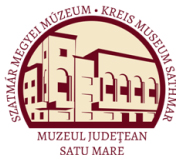Marta, Liviu: The Late Bronze Age Settlements of Petea-Csengersima (Satu Mare, 2009)
VI. Annexes
layer of ash laid over it. Inventory: one bronze knife (PI. 39/13) found in the outline of the pit, 75 ceramic shards (two were re-fired) that originated from at least 15 vessels, one piece of daub, one fragmentary stone, bones. Ten fragments that originated from at least five vessels had excised-incised decorations: one fragment of a bowl (PI. 39/15), one fragment of a vessel with black outside and brick red coloured inside (PI. 39/16). Besides them, were also found one ceramic fragment with a black-burnished side and with another brick red side, as well as one fragment of a fluting rim (PI. 39/14) that was found in the ash layer on the base of the complex together with a few bone fragments. The bronze knife was found at the level of the pit outline, in the soil of the same colour with the rest of the pit fill. Date/culture: In this pit the pottery was characteristic for both the Suciu de Sus culture and the cultural horizon Lăpuş II—Gáva I. Thus exact dating was not possible, perhaps it dated to the transition. Pottery shape Paste Decoration type Pottery type No. of elements Plate amphora s KB 1 39/14 dish s IH,IC 2Bc 1 39/15 s JD 1 39/16 Pot f IB 1 40/1 f IB 1 40/2 f JD 1 40/3 f IB 1 40/4 pot s 1 40/5 cup s IB 1 40/6 cup f 1 40/7 pot f 1 40/8 s IB 1 dish f HB 1 S34 Complex 16 (Fig. 11, 14) — An amorphous pit occurred in the sterile soil. Its maximum length of the outline was 324 cm and the maximum width was 190 cm. The walls varied from steeply inclined towards the inside to arched, and were 25-35 cm high. The base was irregular. In the northern side it was as deep as 84 cm. The fill was dark-grey. Inventory: 55 ceramic shards that originated from sixteen vessels, daub, fragmentary bones. One ceramic fragment had excised-incised decoration. Date/culture: Lăpuş II—Gáva I. S34 Complex 17 (Fig. 11, 14) — A pit with oval oudine (115 x 160 cm) was identified in the sterile soil, in the western corner of complex 16. The walls were 18 cm high, inclined towards the inside. The base was slighdy round. Pit 17 had a dark-grey fill, which was lighter than the fill in the pit 16. The excavation of the latter superimposed the eastern margin of complex 17. No ceramic inventory. Not assigned to an archaeological culture. S34 Complex 18 (Fig. 11, 14) — A pit with slightly oval oudine (112 x 136 cm) occurred in the sterile soil. The walls were 79 cm high, steep in the upper part and convex downwards. The base was slightly irregular and had a maximum diameter of 152 cm. Inventory: two fragments of daub from a hearth, bones, 59 ceramic shards (one was re-fired), that originated from at least 7 vessels. Date/culture: Lăpuş II—Gáva I. 534 Complex 19 (Fig. 11,14) — A pit with oval outline (112 x 164 cm) was found in the sterile soil, in the northern side of complex 16. The walls were 30 cm high and inclined towards the inside. The base was convex. The fill was dark-grey. Its excavation superimposed the northern margin of complex 16. This aspect was obvious as complex 19 was deeper than complex 16. Inventory: 21 ceramic shards (one was re-fired), daub and small bones. The ceramic shards originated from at least 8 vessels. According to the inventory, the pit was not assigned to an archaeological culture but it belonged to the Lăpuş II— Gáva I horizon as it dated a subsequent period to Complex 16. Sector S35 — An excavated cassette in the southern side of an area was destroyed by the works carried out at the construction of the cross-border point (28 m2 in area, Fig. 11, 14). 535 Complex 1 — A daub platform (dwelling structure) was identified in the cultural layer, in 84 cm depth. The daub fragments spread over the entire surface of the cassette, which was 10 m long and 137
